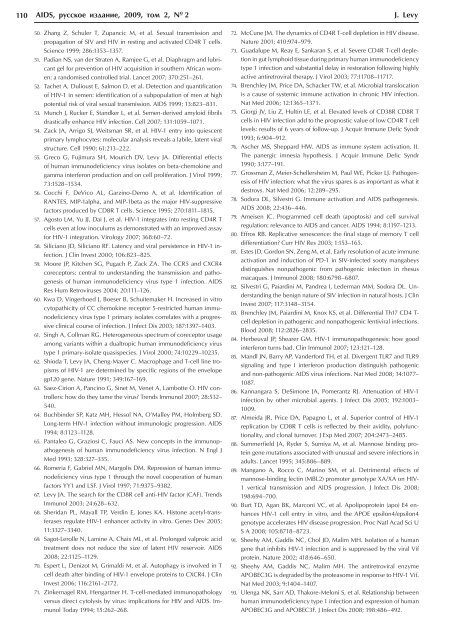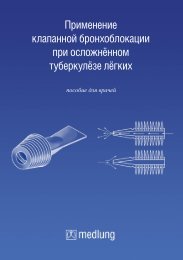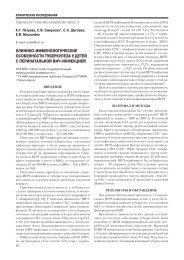Ïàòîãåíåç ÂÈ×-èíôåêöèè: <strong>25</strong> ëåò îòêðûòèé è çàãàäîê1097. Levy JA. HIV and the pathogenesis of AIDS. 3rd ed. Washington,DC: American Society of Microbiology; 2007.8. Gao F, Robertson DL, Car<strong>ru</strong>thers CD, et al. An isolate of human immunodeficiencyvi<strong>ru</strong>s type 1 originally classified as subtype I representsa complex mosaic comprising three different group M subtypes(A, G, and I). J Virol 1998; 72:10234–10241.9. Robertson DL, Sharp PM, McCutchan FE, Hahn BH. Recombinationin HIV-1. Nature 1995; 374:124–126.10. Anderson JP, Rodrigo AG, Learn GH, et al. Testing the hypothesisof a recombinant origin of human immunodeficiency vi<strong>ru</strong>s type 1subtype E. J Virol 2000; 74:10752–10765.11. Abecasis AB, Lemey P, Vidal N, et al. Recombination confounds theearly evolutionary history of human immunodeficiency vi<strong>ru</strong>s type 1:subtype G is a circulating recombinant form. J Virol 2007; 81:8543–8551.12. Clavel F, Guetard D, B<strong>ru</strong>n-Vezinet F, et al. Isolation of a new humanretrovi<strong>ru</strong>s from West African patients with AIDS. Science 1986;233:343–346.13. Peeters M, Toure-Kane C, Nkengasong JN. Genetic diversity of HIVin Africa: impact on diagnosis, treatment, vaccine development andtrials. AIDS 2003; 17:<strong>25</strong>47–<strong>25</strong>60.14. John-Stewart GC, Nduati RW, Rousseau CM, et al. Subtype C is associatedwith increased vaginal shedding of HIV-1. J Infect Dis 2005;192:492–496.15. Jeeninga RE, Hoogenkamp M, Armand-Ugon M, et al. Functionaldifferences between the long terminal repeat transcriptional promotersof human immunodeficiency vi<strong>ru</strong>s type 1 subtypes A through G.J Virol 2000; 74:3740–3751.16. Dirac AMG, Huthoff H, Kjems J, Berkhout B. Requirements for RNAheterodimerization of the human immunodeficiency vi<strong>ru</strong>s type 1(HIV-1) and HIV-2 genomes. J Gen Virol 2002; 83:<strong>25</strong>33–<strong>25</strong>42.17. Levy JA. Is HIV superinfection worrisome? Lancet 2003; 361:98–99.18. Casado C, Pernas M, Alvaro T, et al. Coinfection and superinfectioninpatients with long-term, nonprogressive HIV-1 disease. J Infect Dis2007; 196:895–899.19. Fultz PN. HIV-1 superinfections: omens for vaccine efficacy? AIDS2004; 18:115–119.20. Smith DM, Richman DD, Little SJ. HIV superinfection. J Infect Dis2005; 192:438–444.21. Arien KK, Abraha A, Quinones-Mateu ME, et al. The replicative fitnessof primary human immunodeficiency vi<strong>ru</strong>s type 1 (HIV-1) groupM, HIV-1 group O, and HIV-2 isolates. J Virol 2005; 79:8979–8990.22. Kaleebu P, French N, Mahe C, et al. Effect of human immunodeficiencyvi<strong>ru</strong>s (HIV) type 1 envelope subtypes A and D on diseaseprogression in a large cohort of HIV-1-positive persons in Uganda. JInfect Dis 2002; 185:1244–1<strong>25</strong>0.23. Rowland-Jones SL, Whittle HC. Out of Africa: what can we learnfrom HIV-2 about protective immunity to HIV-1? Nat Immunol 2007;8:329–331.24. Reeves JD, Doms RW. Human immunodeficiency vi<strong>ru</strong>s type 2. J GenVirol 2002; 83:1<strong>25</strong>3–1265.<strong>25</strong>. Keys B, Karis J, Fadeel B, et al. V3 sequences of paired HIV-1 isolatesfrom blood and cerebrospinal fluid cluster according to host andshow variation related to the clinical stage of disease. Virology 1993;196:475–483.26. Wong JK, Ignacio CC, Torriani F, et al. In vivo compartmentalizationof human immunodeficiency vi<strong>ru</strong>s: evidence from the examinationof pol sequences from autopsy tissues. J Virol 1997; 71:2059–2071.27. Fulcher JA, Hwangbo Y, Zioni R, et al. Compartmentalization of humanimmunodeficiency vi<strong>ru</strong>s type 1 between blood monocytes andCD4R T cells during infection. J Virol 2004; 78:7883–7893.28. Bushman FD, Hoffmann C, Ronen K, et al. Massively parallel pyrosequencingin HIV research. AIDS 2008; 22:1411–1415.29. Berger EA, Murphy PM, Farber JM. Chemokine receptors as HIV-1coreceptors: roles in viral entry, tropism, and disease. Annu Rev Immunol1999; 17:657–700.30. Tersmette M, de Goede REY, Bert JM, et al. Differential syncytium-inducingcapacity of human immunodeficiency vi<strong>ru</strong>s isolates: frequentdetection of syncytium-inducing isolates in patients with acquiredimmunodeficiency syndrome (AIDS) and AIDS-related complex. JVirol 1988; 62:2026–2032.31. Edinger AL, Clements JE, Doms RW. Chemokine and orphan receptorsin HIV-2 and SIV tropism and pathogenesis. Virology 1999;260:211–221.32. Harouse JM, Bhat S, Spitalnik SL, et al. Inhibition of entry of HIV-1 inneural cell lines by antibodies against galactosyl ceramide. Science1991; <strong>25</strong>3:320–323.33. Yahi N, Baghdiguian S, Moreau H, Fantini J. Galactosyl ceramide (ora closely related molecule) is the receptor for human immunodeficiencyvi<strong>ru</strong>s type 1 on human colon epithelial HT29 cells. J Virol1992; 66:4848–4854.34. Fu<strong>ru</strong>ta Y, Eriksson K, Svennerholm B, et al. Infection of vaginal andcolonic epithelial cells by the human immunodeficiency vi<strong>ru</strong>s type1 is neutralized by antibodies raised against conserved epitopes inthe envelope glycoprotein gp120. Proc Natl Acad Sci U S A 1994;91:1<strong>25</strong>59–1<strong>25</strong>63.35. Robinson WE Jr, Montefiori DC, Mitchell WM. Antibody-dependentenhancement of human immunodeficiency vi<strong>ru</strong>s type 1 infection.Lancet 1988; i:790–794.36. Homsy J, Meyer M, Tateno M, Clarkson S, Levy JA. The Fc and notthe CD4 receptor mediates antibody enhancement of HIV infectionin human cells. Science 1989; 244:1357–1360.37. Hioe CE, Bastiani L, Hildreth JE, Zolla-Pazner S. Role of cellular adhesionmolecules in HIV type 1 infection and their impact on vi<strong>ru</strong>sneutralization. AIDS Res Hum Retrovi<strong>ru</strong>ses 1998; 14:S124–S<strong>25</strong>4.38. Bounou S, Leclerc JE, Tremblay MJ. Presence of host ICAM-1 in laboratoryand clinical strains of human immunodeficiency vi<strong>ru</strong>s type1 increases vi<strong>ru</strong>s infectivity and CD4(R)-T- cell depletion in humanlymphoid tissue, a major site of replication in vivo. J Virol 2002;76:1004–1014.39. Arthos J, Cicala C, Martinelli E, et al. HIV-1 envelope protein bindsto and signals through integrin alpha4beta7, the gut mucosal homingreceptor for peripheral T cells. Nat Immunol 2008; 9:301–309.40. Keele BF, Giorgi EE, Salazar-Gonzalez JF, et al. Identification andcharacterization of transmitted and early founder vi<strong>ru</strong>s envelopes inprimary HIV-1 infection. Proc Natl Acad Sci U S A 2008; 105:7552–7557.41. Levy JA. The transmission of AIDS: the case of the infected cell.JAMA 1988; <strong>25</strong>9:3037–3038.42. Phillips DM, Bourinbaiar AS. Mechanism of HIV spread from lymphocytesto epithelia. Virology 1992; 186:261–273.43. Kaizu M, Weiler AM, Weisgrau KL, et al. Repeated intravaginal inoculationwith cell-associated simian immunodeficiency vi<strong>ru</strong>s resultsin persistent infection of nonhuman primates. J Infect Dis 2006;194:912–916.44. Gupta P, Mellors J, Kingsley L, et al. High viral load in semen of humanimmunodeficiency vi<strong>ru</strong>s type 1-infected men at all stages of diseaseand its reduction by therapy with protease and nonnucleosidereverse transcriptase inhibitors. J Virol 1997; 71:6271–6275.45. Hollingsworth TD, Anderson RM, Fraser C. HIV-1 transmission, bystage of infection. J Infect Dis 2008; 198:687–693.46. Atkins MC, Carlin EM, Emery VC, Griffiths PD, Boag F. Fluctuationsof HIV load in semen of HIV positive patients with newly acquiredsexually transmitted diseases. BMJ 1996; 313:341–342.47. Halperin DT, Bailey RC. Male circumcision and HIV infection: 10years and counting. Lancet 1999; 354:1813–1815.48. Auvert B, Taljaard D, Lagarde E, et al. Randomized, controlled interventiontrial of male circumcision for reduction of HIV infection risk:the ANRS 1265 Trial. PLoS Med 2005; 2:e298.49. Coombs RW, Reichelderfer PS, Landay AL. Recent observations onHIV type-1 infection in the genital tract of men and women. AIDS2003; 17:455–480.
110 AIDS, ðóññêîå èçäàíèå, 2009, òîì 2, N¹ 2 J. Levy50. Zhang Z, Schuler T, Zupancic M, et al. Sexual transmission andpropagation of SIV and HIV in resting and activated CD4R T cells.Science 1999; 286:1353–1357.51. Padian NS, van der Straten A, Ramjee G, et al. Diaphragm and lubricantgel for prevention of HIV acquisition in southern African women:a randomised controlled trial. Lancet 2007; 370:<strong>25</strong>1–261.52. Tachet A, Dulioust E, Salmon D, et al. Detection and quantificationof HIV-1 in semen: identification of a subpopulation of men at highpotential risk of viral sexual transmission. AIDS 1999; 13:823–831.53. Munch J, Rucker E, Standker L, et al. Semen-derived amyloid fibrilsdrastically enhance HIV infection. Cell 2007; 131:1059–1071.54. Zack JA, Arrigo SJ, Weitsman SR, et al. HIV-1 entry into quiescentprimary lymphocytes: molecular analysis reveals a labile, latent viralst<strong>ru</strong>cture. Cell 1990; 61:213–222.55. Greco G, Fujimura SH, Mourich DV, Levy JA. Differential effectsof human immunodeficiency vi<strong>ru</strong>s isolates on beta-chemokine andgamma interferon production and on cell proliferation. J Virol 1999;73:1528–1534.56. Cocchi F, DeVico AL, Garzino-Demo A, et al. Identification ofRANTES, MIP-1alpha, and MIP-1beta as the major HIV-suppressivefactors produced by CD8R T cells. Science 1995; 270:1811–1815.57. Agosto LM, Yu JJ, Dai J, et al. HIV-1 integrates into resting CD4R Tcells even at low inoculums as demonstrated with an improved assayfor HIV-1 integration. Virology 2007; 368:60–72.58. Siliciano JD, Siliciano RF. Latency and viral persistence in HIV-1 infection.J Clin Invest 2000; 106:823–8<strong>25</strong>.59. Moore JP, Kitchen SG, Pugach P, Zack ZA. The CCR5 and CXCR4coreceptors: central to understanding the transmission and pathogenesisof human immunodeficiency vi<strong>ru</strong>s type 1 infection. AIDSRes Hum Retrovi<strong>ru</strong>ses 2004; 20:111–126.60. Kwa D, Vingerhoed J, Boeser B, Schuitemaker H. Increased in vitrocytopathicity of CC chemokine receptor 5-restricted human immunodeficiencyvi<strong>ru</strong>s type 1 primary isolates correlates with a progressiveclinical course of infection. J Infect Dis 2003; 187:1397–1403.61. Singh A, Collman RG. Heterogeneous spect<strong>ru</strong>m of coreceptor usageamong variants within a dualtropic human immunodeficiency vi<strong>ru</strong>stype 1 primary-isolate quasispecies. J Virol 2000; 74:10229–10235.62. Shioda T, Levy JA, Cheng-Mayer C. Macrophage and T-cell line tropismsof HIV-1 are determined by specific regions of the envelopegp120 gene. Nature 1991; 349:167–169.63. Saez-Cirion A, Pancino G, Sinet M, Venet A, Lambotte O. HIV controllers:how do they tame the vi<strong>ru</strong>s? Trends Immunol 2007; 28:532–540.64. Buchbinder SP, Katz MH, Hessol NA, O’Malley PM, Holmberg SD.Long-term HIV-1 infection without immunologic progression. AIDS1994; 8:1123–1128.65. Pantaleo G, Graziosi C, Fauci AS. New concepts in the immunopathogenesisof human immunodeficiency vi<strong>ru</strong>s infection. N Engl JMed 1993; 328:327–335.66. Romeria F, Gabriel MN, Margolis DM. Repression of human immunodeficiencyvi<strong>ru</strong>s type 1 through the novel cooperation of humanfactors YY1 and LSF. J Virol 1997; 71:9375–9382.67. Levy JA. The search for the CD8R cell anti-HIV factor (CAF). TrendsImmunol 2003; 24:628–632.68. Sheridan PL, Mayall TP, Verdin E, Jones KA. Histone acetyl-transferasesregulate HIV-1 enhancer activity in vitro. Genes Dev 2005;11:3327–3340.69. Sagot-Lerolle N, Lamine A, Chaix ML, et al. Prolonged valproic acidtreatment does not reduce the size of latent HIV reservoir. AIDS2008; 22:11<strong>25</strong>–1129.70. Espert L, Denizot M, Grimaldi M, et al. Autophagy is involved in Tcell death after binding of HIV-1 envelope proteins to CXCR4. J ClinInvest 2006; 116:2161–2172.71. Zinkernagel RM, Hengartner H. T-cell-mediated immunopathologyversus direct cytolysis by vi<strong>ru</strong>s: implications for HIV and AIDS. ImmunolToday 1994; 15:262–268.72. McCune JM. The dynamics of CD4R T-cell depletion in HIV disease.Nature 2001; 410:974–979.73. Guadalupe M, Reay E, Sankaran S, et al. Severe CD4R T-cell depletionin gut lymphoid tissue during primary human immunodeficiencytype 1 infection and substantial delay in restoration following highlyactive antiretroviral therapy. J Virol 2003; 77:11708–11717.74. Brenchley JM, Price DA, Schacker TW, et al. Microbial translocationis a cause of systemic immune activation in chronic HIV infection.Nat Med 2006; 12:1365–1371.75. Giorgi JV, Liu Z, Hultin LE, et al. Elevated levels of CD38R CD8R Tcells in HIV infection add to the prognostic value of low CD4R T celllevels: results of 6 years of follow-up. J Acquir Immune Defic Syndr1993; 6:904–912.76. Ascher MS, Sheppard HW. AIDS as immune system activation. II.The panergic imnesia hypothesis. J Acquir Immune Defic Syndr1990; 3:177–191.77. Grossman Z, Meier-Schellersheim M, Paul WE, Picker LJ. Pathogenesisof HIV infection: what the vi<strong>ru</strong>s spares is as important as what itdestroys. Nat Med 2006; 12:289–295.78. Sodora DL, Silvestri G. Immune activation and AIDS pathogenesis.AIDS 2008; 22:436–446.79. Ameisen JC. Programmed cell death (apoptosis) and cell survivalregulation: relevance to AIDS and cancer. AIDS 1994; 8:1197–1213.80. Effros RB. Replicative senescence: the final stage of memory T celldifferentiation? Curr HIV Res 2003; 1:153–165.81. Estes JD, Gordon SN, Zeng M, et al. Early resolution of acute immuneactivation and induction of PD-1 in SIV-infected sooty mangabeysdistinguishes nonpathogenic from pathogenic infection in rhesusmacaques. J Immunol 2008; 180:6798–6807.82. Silvestri G, Paiardini M, Pandrea I, Lederman MM, Sodora DL. Understandingthe benign nature of SIV infection in natural hosts. J ClinInvest 2007; 117:3148–3154.83. Brenchley JM, Paiardini M, Knox KS, et al. Differential Th17 CD4 T-cell depletion in pathogenic and nonpathogenic lentiviral infections.Blood 2008; 112:2826–2835.84. Herbeuval JP, Shearer GM. HIV-1 immunopathogenesis: how goodinterferon turns bad. Clin Immunol 2007; 123:121–128.85. Mandl JN, Barry AP, Vanderford TH, et al. Divergent TLR7 and TLR9signaling and type I interferon production distinguish pathogenicand non-pathogenic AIDS vi<strong>ru</strong>s infections. Nat Med 2008; 14:1077–1087.86. Kannangara S, DeSimone JA, Pomerantz RJ. Attenuation of HIV-1infection by other microbial agents. J Infect Dis 2005; 192:1003–1009.87. Almeida JR, Price DA, Papagno L, et al. Superior control of HIV-1replication by CD8R T cells is reflected by their avidity, polyfunctionality,and clonal turnover. J Exp Med 2007; 204:2473–2485.88. Summerfield JA, Ryder S, Sumiya M, et al. Mannose binding proteingene mutations associated with unusual and severe infections inadults. Lancet 1995; 345:886–889.89. Mangano A, Rocco C, Marino SM, et al. Detrimental effects ofmannose-binding lectin (MBL2) promoter genotype XA/XA on HIV-1 vertical transmission and AIDS progression. J Infect Dis 2008;198:694–700.90. Burt TD, Agan BK, Marconi VC, et al. Apolipoprotein (apo) E4 enhancesHIV-1 cell entry in vitro, and the APOE epsilon4/epsilon4genotype accelerates HIV disease progression. Proc Natl Acad Sci US A 2008; 105:8718–8723.91. Sheehy AM, Gaddis NC, Chol JD, Malim MH. Isolation of a humangene that inhibits HIV-1 infection and is suppressed by the viral Vifprotein. Nature 2002; 418:646–650.92. Sheehy AM, Gaddis NC, Malim MH. The antiretroviral enzymeAPOBEC3G is degraded by the proteasome in response to HIV-1 Vif.Nat Med 2003; 9:1404–1407.93. Ulenga NK, Sarr AD, Thakore-Meloni S, et al. Relationship betweenhuman immunodeficiency type 1 infection and expression of humanAPOBEC3G and APOBEC3F. J Infect Dis 2008; 198:486–492.
- Page 3 and 4: РУССКОЕ ИЗДАНИЕПре
- Page 7 and 8: Òîì 2 N¹ 2 Àïðåëü - È
- Page 9 and 10: 100 AIDS, ðóññêîå èçäàí
- Page 11 and 12: 102 AIDS, ðóññêîå èçäàí
- Page 13 and 14: 104 AIDS, ðóññêîå èçäàí
- Page 15 and 16: 106 AIDS, ðóññêîå èçäàí
- Page 17: 108 AIDS, ðóññêîå èçäàí
- Page 21 and 22: 112 AIDS, ðóññêîå èçäàí
- Page 23 and 24: 114 AIDS, ðóññêîå èçäàí
- Page 26 and 27: Ôàðìàêîëîãèÿ ïðîòè
- Page 28 and 29: Ôàðìàêîëîãèÿ ïðîòè
- Page 30 and 31: Ôàðìàêîëîãèÿ ïðîòè
- Page 32 and 33: ÎÁÇÎÐÛ ÐÅÄÀÊÖÈÈÇîë
- Page 34 and 35: Çîëåäðîíîâàÿ êèñëî
- Page 36 and 37: Çîëåäðîíîâàÿ êèñëî
- Page 38 and 39: Çîëåäðîíîâàÿ êèñëî
- Page 40 and 41: Çîëåäðîíîâàÿ êèñëî
- Page 42 and 43: Òîì 2 N¹ 2 Àïðåëü - È
- Page 44 and 45: 136 AIDS, ðóññêîå èçäàí
- Page 46 and 47: 138 AIDS, ðóññêîå èçäàí
- Page 48 and 49: 140 AIDS, ðóññêîå èçäàí
- Page 50 and 51: ÊËÈÍÈ×ÅÑÊÈÅ ÈÑÑËÅÄ
- Page 52 and 53: 144 AIDS, ðóññêîå èçäàí
- Page 54 and 55: 146 AIDS, ðóññêîå èçäàí
- Page 56 and 57: 148 AIDS, ðóññêîå èçäàí
- Page 58 and 59: 150 AIDS, ðóññêîå èçäàí
- Page 60 and 61: 152 AIDS, ðóññêîå èçäàí
- Page 62 and 63: 154 AIDS, ðóññêîå èçäàí
- Page 64 and 65: ÊËÈÍÈ×ÅÑÊÈÅ ÈÑÑËÅÄ
- Page 66 and 67: ÝÏÈÄÅÌÈÎËÎÃÈß È ÑÎ
- Page 68 and 69:
Ñâÿçü ìåæäó Mycoplasma ge
- Page 70 and 71:
Ñâÿçü ìåæäó Mycoplasma ge
- Page 72 and 73:
Ñâÿçü ìåæäó Mycoplasma ge
- Page 74 and 75:
Ñâÿçü ìåæäó Mycoplasma ge
- Page 76 and 77:
Ñâÿçü ìåæäó Mycoplasma ge
- Page 78 and 79:
Òîì 2 N¹ 2 Àïðåëü - È
- Page 80 and 81:
174 AIDS, ðóññêîå èçäàí
- Page 82 and 83:
176 AIDS, ðóññêîå èçäàí
- Page 84 and 85:
ÑÎÎÁÙÅÍÈß ÈÑÑËÅÄÎÂ
- Page 86 and 87:
ÑÎÎÁÙÅÍÈß ÈÑÑËÅÄÎÂ
- Page 88 and 89:
182 AIDS, ðóññêîå èçäàí
- Page 90 and 91:
184 AIDS, ðóññêîå èçäàí
- Page 92:
186 AIDS, ðóññêîå èçäàí
















